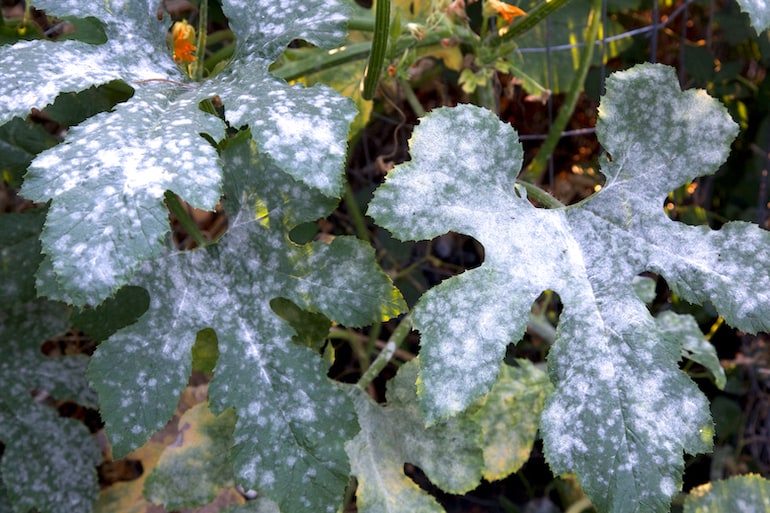Garden diseases - Powdery Mildew

Powdery mildew affects a wide variety of plants
Image: Julie Vader/Shutterstock
Powdery mildew affects the leaves and stems of a wide variety of plants. Early signs are small white spots on the front and back of leaves, but powdery mildew soon covers foliage, making plants look like they’ve been doused in talcum powder.
Left untreated, this infection is unsightly, stresses the plant and ultimately leads to lower yields, and may eventually cause plants to die. The good news is that powdery mildew is treatable – find out how below.
What is powdery mildew?
Powdery mildew refers to a wide array of related fungi which attack leaves stems and flowers. Individual varieties of fungus usually only affect a narrow range of plants, so just because your geraniums show signs of infection, doesn’t mean your courgettes will get it too, although cucurbits like courgettes, squashes and pumpkins do tend to be susceptible to powdery white mildew.
Although it looks bad, powdery mildew is a superficial infection – it doesn’t kill the leaf directly, but feeds on sugars within the leaf and prevents the sun reaching the plant surface. Over time this weakens the plant.
How to recognise powdery mildew

Speckled white spots on leaves indicate powdery mildew
Image: TMsara/Shutterstock
Look for small white spots on both the surface and the underside of leaves, or more widespread “dusting” of foliage, flowers, and even fruit. Unchecked, powdery mildew spreads fast and may cause leaves to distort, discolour, and eventually die.
Easily recognisable on most plants, nevertheless, check carefully – the sooner you treat an infection of powdery mildew, the better.
How do I treat powdery mildew?

Stop the infection from spreading by removing the damaged leaves
Image: agrofruti/Shutterstock
Treatment options for powdery mildew range from physically removing the infected parts of the plant, to using proprietary and home-made sprays.
If you decide to prune out infected leaves, you should dispose of them by burning or putting in your rubbish bin. Heaping fungus infected foliage on your compost heap only creates a repository for fungal spores which will be ready to reinfect your plants next spring.
Home treatments for powdery mildew include:
- A 10% milk solution – simply mix milk and water and give your plants a thorough spray.
- Baking soda fungicide solution – to 500ml water, add one to three teaspoons of bicarbonate of soda, one teaspoon of vegetable oil, a little squirt of eco-detergent to act as an emulsifier. Mix and pour into a spray bottle. Shake and spray.
To treat powdery mildew with a proprietary spray, it’s important to follow manufacturers’ instructions, and if you’re treating fruit or veg crops, do check the spray is suitable for use on edible plants.
How do I prevent powdery mildew?

Watering the roots and not the leaves will help deter powdery mildew
Image: amenic181/Shutterstock
Warm, wet weather, poor ventilation, and water stress encourage fungal infections, but there are some things you can do to deter powdery mildew.
- Mulch around the base of plants helps to keep the moisture in the soil – important for keeping plants strong even in dry weather.
- When growing plants indoors or in the greenhouse, make sure the space is well ventilated.
- Water the roots of plants – wet leaves are a welcoming environment for fungal spores.
By taking steps to prevent and treat powdery mildew, you’ll soon get on top of the problem.
Other pages you might like
See all pests & diseases guides
Individual guides
Diseases
- Apple scab
- Bacterial canker
- Blackleg
- Blossom wilt
- Botrytis
- Brown rot
- Clematis wilt
- Downy mildew
- Fungal disease
- Honey fungus
- Leaf scorch
- Leaf spot
- Leek rust
- Lily disease
- Peach leaf curl
- Pear rust
- Phytophthora root rot
- Potato & tomato blight
- Silver leaf fungus
- Tomato greenback
- Tomato leaf curl
- Tomato stem canker







